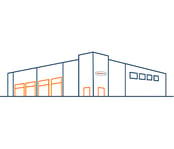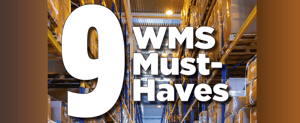
When shopping for a warehouse management system, one size doesn’t fit all. To narrow your search, look for solutions with these must-have features to meet your current and future business demands.
Disruption from the pandemic laid bare the shortcomings of some warehouse and distribution operations still relying on outdated, inadequate systems. As buyers flooded e-commerce sites with orders, and shippers struggled with trucking capacity, outdated or ad hoc systems couldn’t keep pace.
A modern warehouse management system (WMS) can help shippers tame the turmoil by digitally managing inventory and shipping processes. WMS offerings have boomed in the past few years, so shippers can choose from a range of solutions.
Some solutions are targeted at e-commerce companies and some are suited for middle-tier companies, while others are positioned for the largest companies with the resources to make it work. But a sophisticated, scalable WMS can be affordable for a smaller company that starts with basic functionality and adds capabilities as the business grows.
Technology advances such as cloud computing and software, and infrastructure as a service, mean companies don’t have to invest in expensive computer hardware—like an IBM AS/400—as they may have done in the past. Now users can access a WMS from practically any computer or mobile device.
“There are many more systems today that are affordable for mid-market companies,” says Amit Levy, executive vice president of customer solutions and strategy at Made4net, a supply chain software developer based in New Jersey.
When should a company consider implementing a WMS or upgrading a current system? When inventory accuracy starts falling into the 70-80% range, and labor costs rise because of the need for manual counting.
“Companies that may have started small by managing inventory on paper or in spreadsheets, but now are not able to reconcile inventory with their enterprise resource planning (ERP) system, know they need help,” notes Raj Patel, senior director, 3PL global industry strategy, at software company Blue Yonder.
One size doesn’t fit all, so understand what your supply chain needs and what it doesn’t. A company can invest in a WMS directly or adopt a system through a third-party logistics provider relationship. If you’re considering a WMS for your operations, consider these must-haves to meet current and future needs.
1. ARCHITECTURE
Look for a system that supports flexibility and scalability to adapt to business requirements and new technology. Ideally, end users can manage shipping methods, products, locations, and other aspects without going back to the provider for additional programming. The WMS also should support seasonality, high volumes, and temporary employees using the system. “You don’t want to spend the money and then not be able to use the WMS in 5 to 10 years because your business has outgrown it,” Levy says.
2. FUNCTIONALITY
Critical functions depend on the volume of the operation and complexity of products—frozen foods or oversize home goods, for example, require a different solution than fast fashion or electronics. In any case, a WMS will optimize day-to-day warehouse operations and provide a higher level of efficiency to satisfy customers and the bottom line. Any WMS should offer a few table stakes functions. The extra bells and whistles, like business intelligence analytics and labor management, are available for those companies that need them and can afford them. Even the most basic WMS should provide product receiving, put-away, and order allocation, which offer real-time inventory visibility. Picking, packing, and shipping, including building and printing shipping documents and labels, are also necessary in most cases. Some systems support dynamic slotting so fast-selling products can be placed in the right bin or rack to shave a few seconds off each pick. Some users need additional capabilities, such as serial number or lot tracking from receiving through shipping, or bill of material breaking and kitting. “All WMS providers offer 80% of the same functions; it’s the 20% that’s unique to you that makes the difference,” Patel says.
3. EASE OF USE
Given the ongoing competition for labor, a WMS should be easy for new users to learn and be able to add temporary users on the fly to handle seasonal surges. “With people changing jobs, and onboarding new resources, ask potential WMS vendors how quickly users can learn the system,” Patel says. “You don’t want to train people for days.”
4. INTEGRATION
It’s critical for a WMS to work and play well with others. It should connect easily to an ERP, transportation management system, order management system, and warehouse execution system. As more facilities install automatic storage and retrieval systems and robotics from multiple vendors, ease of integration could be a deal-breaker. “Having a solution you can integrate with is critical,” says Michael Roberts, chief information officer at ODW Logistics, a Columbus, Ohio-based 3PL.
5. SCALABILITY
WMS requirements depend on the size and complexity of the organization now and the growth potential for the future. Lower-cost software-as-a-service systems may suffice for a straightforward distribution network, but they may not provide the analytics and business intelligence to help take a company to the next level. “If you are comfortable living within the constraints of ‘this is what you get and this is how it works’, that can be a cost-effective way to get into a WMS,” Roberts says. A small retailer may not need sophisticated functionalities initially, but it should adopt a WMS that will scale with the business. A retailer may serve e-commerce and its own stores now but could expand to serve other distributor and retail partners as well as other e-commerce channels. The order profile may vary from delivering a single item to a consumer to sending pallet loads to distribution centers. “As a company grows, it can start with the base level and upgrade with higher functionality,” Patel says.
6. LABOR MANAGEMENT & PLANNING
The WMS should identify the best path for workers to nd the correct inventory to pick eaches or boxes. Add a gamification element by communicating workers’ productivity. An intelligent labor management system will provide industry guidelines for productivity. For example, a worker should be able to pick a certain amount of product in one hour, depending on product size and picking methodology. In some of its warehouses, 3PL Kenco Logistics uses gamification that compares employee performance against the standards set for each warehouse. “It gives workers direct feedback in the moment if they’re running ahead or running behind,” says Kristi Montgomery, vice president of innovation. Some companies may offer labor management as a standalone module that could be used with any WMS. Some systems will also match an employee’s skills or qualifications to the job. For example, if an injured employee is restricted to light-duty tasks, the system will assign them to appropriate duties.
7. COMFORT LEVEL
While there are many WMS providers, even those in the business say there aren’t significant differences among them. Work with a provider that offers a comfort level with your corporate culture and provides the functionality your company requires. “You may pay more to go with a reputable provider, but they have the depth and breadth of technology experience, and a broad customer base, so they will be around longer,” Levy says.
8. DIGITIZATION
It’s amazing how much paper some companies still use, Roberts notes. A WMS helps digitize operations with electronic bills of lading and signatures. That makes carriers more efficient during gate checks at the facility and provides contactless services. Digital processes also support real-time business intelligence and analytics.
9. FUTURE TECHNOLOGY
Autonomous vehicles, drones, automated pallet building and shrink wrapping, and other intelligent systems will play a more significant role as labor costs rise. If your organization plans to adopt emerging technologies, look for a WMS that makes it easy. “The labor savings can be huge, and you can focus your resources on adding value,” Roberts says.
Source:
https://resources.inboundlogistics.com/digital/issues/IL_Digital_September2021.pdf
ODW Logistics
Since 1971, we’ve been providing warehousing, distribution, and transportation solutions for hundreds of brands. We operate as an extension of your business to control costs throughout your supply chain that deliver you a competitive advantage over your competition.RECENT POSTS
Streamlining Your Supply Chain for Maximum Efficiency Navigating the Complexities of Modern Grocery Retail The supply ch...
Dec. 03, 2024 09:13 AM
ODW Logistics is expanding its Columbus operations with a newly designed, state-of-the-art distribution campus. This adv...
Nov. 26, 2024 09:41 AM
Columbus, Ohio—2024 — Food Logistics, the only publication exclusively dedicated to covering the movement of product thr...
Oct. 21, 2024 10:52 AM









.png)

